The Art & Artists of New York’s Radio City Music Hall

A world-renowned theater celebrated for hosting everyone and everything from Prince to the WNBA to Frank Sinatra’s official debut of New York, New York [1], Radio City Music Hall also offers patrons a wonderful collection of curated art. Art which can easily be missed in the overwhelm of a busy night at RCMH.
Art on the ground. Art on the walls. Take a moment and have a closer look. The Humble Fabulist and TV mini-series like Pretend It’s a City (featuring Fran Lebowitz and Martin Scorsese) suggest that there is great joy in doing just that.
A long list of creatives left their mark on Radio City Music Hall — architects, painters, designers. Each led a fascinating life, a life of consequence — however small that consequence might seem in the grande scheme of things.
These are the artists who clothed Radio City Music Hall, a well-loved institution of New York City. Their art has withstood the challenges of these last 89 years and perhaps that, in and of itself, is what warrants recognition.
Table of Contents
Ruth Reeves
Marguerita Mergentime
Yasuo Kuniyoshi
Witold Gordon
Henry Billings
Hildreth Meière
Rene Paul Chambellan
William Zorach
Gwen Lux
Robert Laurent
Ezra Winter
Louis Bouché
Eduard “Buk” Ulreich
Stuart Davis
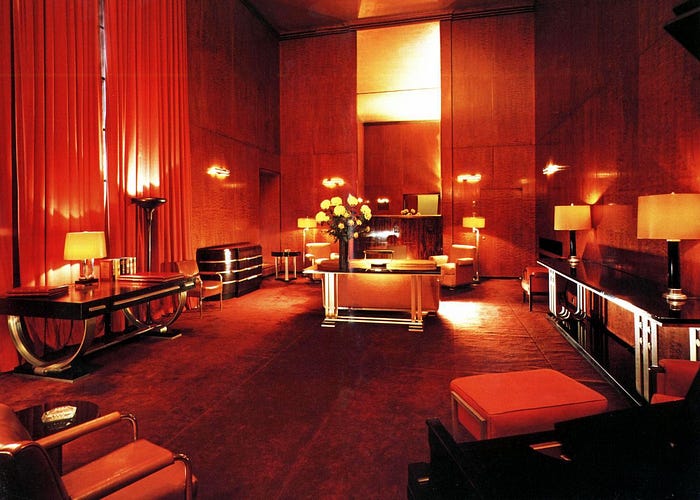
Donald Deskey (1894–1989)
In early 1932, Donald Deskey submitted his designs through a competition in a bid to oversee the interior styling of the soon-to-be Radio City Music Hall. His work stood out and he was chosen to decorate the theater.
The project demanded that Deskey deliver on the modernity Art Deco aesthetics while meeting the need for functionality in a public building. He chose artists who worked in a wide range of styles and mediums, managing to weave them harmoniously into the fabric of the Radio City Music Hall we recognize today.
An array of Deskey’s is displayed throughout Radio City Music Hall, with a well-maintained collection of furniture in the “secret apartment” known as the Roxy Suite above the stage [2].

A replica of Deskey’s “Singing Women” design, a patterned textile covering the floor of the main auditorium, was reproduced in nylon and wool in the 1990s. Much of the RCMH building was refreshed at that time after narrowly escaping demolition[3].
The “Nicotine Room,” a Men’s Lounge on the second floor of Radio City Music Hall, houses Deskey’s The History of Nicotine (The Life of Saint Nicotine.) The print is stamped in a “tobacco brown” across aluminum foil wallpaper. Cleverly, the foil itself was produced by the R. J. Reynolds Tobacco Company [4].
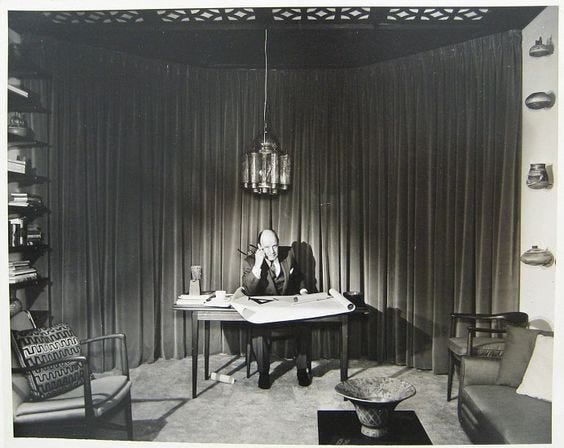
Edward Durell Stone (1902 — 1978)
Edward Durell Stone began his architectural design career inspired by the International Style, eventually leaning into less austere designs as his career progressed [5]. His work as the architect for the Art Deco Radio City Music Hall building shows his less conservative side.
Stone orchestrated many buildings of note across America, often working with fellow architect Philip L. Goodwin. His widely acclaimed architectural design for the U.S. embassy in New Delhi further enhanced Stone’s exposure internationally.
Radio City Music Hall is just one of several iconic buildings in Edward Durell Stone’s prolific New York City portfolio. You may recognize his work as the office buildings and places of culture throughout the city: 1 Financial Square, 2 Columbus Circle (currently houses the Museum of Arts and Design), the Museum of Modern Art (MoMA) and the Edward Durell Stone House are his.
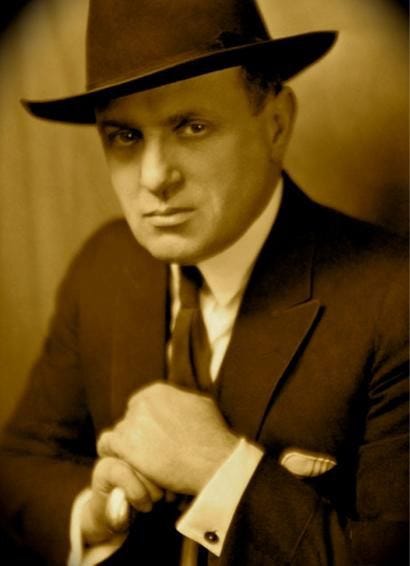
Samuel Lionel “Roxy” Rothafel (1882 — 1936)
Better known simply as “Roxy,” Mr.Rothafel was the fanciful mind behind the movie palace concept. He bolstered theater shows, such as those at the R.K.O. and Radio City Music Hall, with the addition of live music, entertainment during intermissions and a lavish visual atmosphere.
To understand Roxy’s brand of entertainment, one need only look to the Radio City Rockettes. The Rockettes, originally the Roxyettes, were brought onboard Radio City at Roxy’s prompting[6]. The Rockettes are now inseparable, even synonymous with RCMH and its annual Christmas Spectacular Show.

Though Roxy resigned from Radio City Music Hall shortly after its opening [7], his influence can still be felt in the spirit of the building. The layered ceiling of the auditorium, reminiscent of warm waves of sunlight radiating from the stage, was Roxy’s take on theater decor — inspired by a cruiseliner he once travelled on [8].
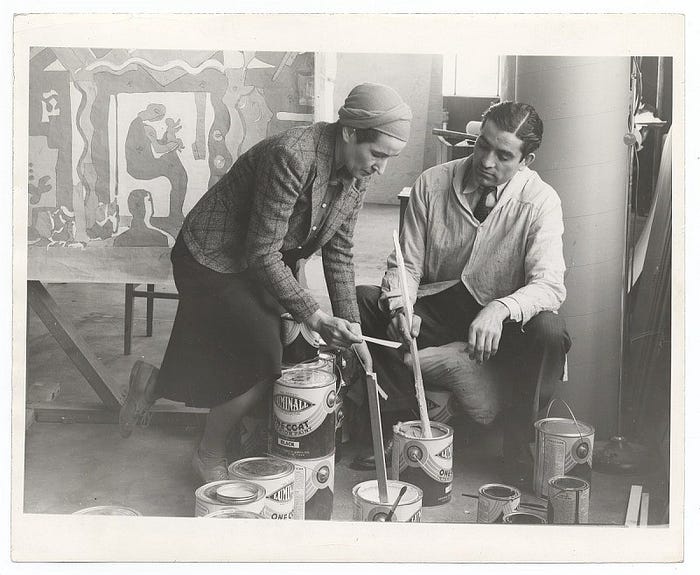
Ruth Reeves (1892–1966)
Ruth Reeves’ textiles cover large swaths of the main floor of Radio City Music Hall. You may find that her textile designs add to the sense of excitement as you step into the theater.
Still Life with Musical Instruments, Reeves’ Art Deco interpretation of cocktail glasses and guitars caught up in a tango, covers the staircases, Grand Foyer and elevators of Radio City Music Hall. Her works bring a feeling of joy to Radio City.
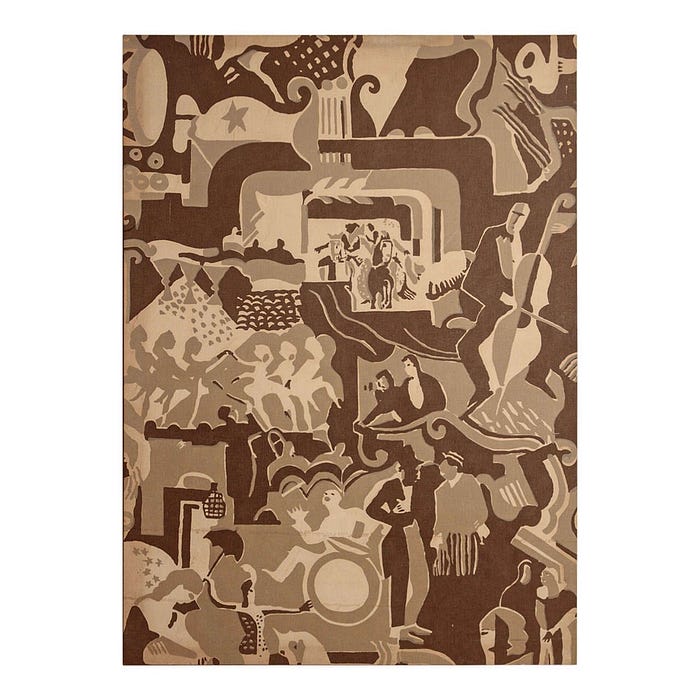
The entire back wall of Radio City Music Hall’s auditorium is adorned with yet another fabric creation by Reeves entitled The History of Theatre. Ballerinas, circus performers and saxophones play on a loop in this textile fever dream of New York aspirations.
Ruth Reeves excelled at taming wild patterns and colors, making them charming rather than obnoxious. The bold images she worked with were ideal for scarves, housewares and tablecloths.
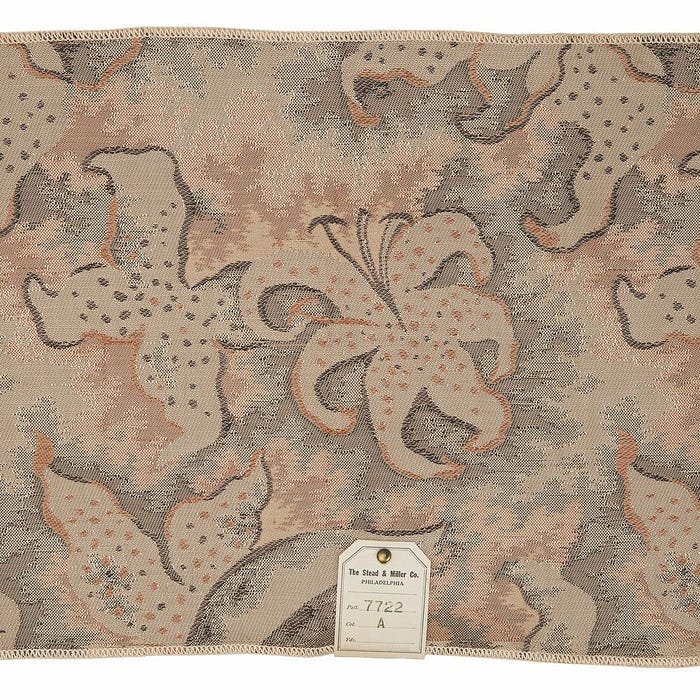
Marguerita Mergentime (1894–1941)
Gracing the walls of the Grand Lounge Ladies’ Room, you will find a reproduction of Marguerita Mergentime’s Lilies in the Air framing the Art Deco wall mirrors. Photographs really cannot do it justice; you must stand before it and admire the details Mergentime so thoughtfully included.

A second piece of Mergentime’s work in RCMH is showcased as carpeting nearby, alongside a miniature working model of Radio City Music Hall’s famous stage [9]. The textile’s wild line work design is subdued only by its muted colors. It pairs nicely with the building’s Art Deco gold accents.
Mergentime’s works remain adored and are still available for purchase as tablecloths and tea towels for the discerning decorator. A review of Marguerita Mergentime’s career as an artist can be explored in depth in the book Marguerita Mergentime: American Textiles, Modern Ideas, contributed to by her granddaughter, Virginia Bayer.
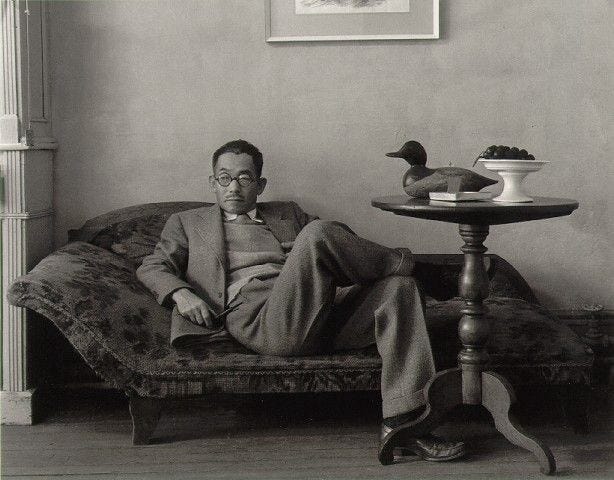
Yasuo Kuniyoshi (1889–1983)
Perhaps the most calming of the lounges in Radio City Music Hall is Yasuo Kuniyoshi’s painted landscape Ladies’ Lounge. Deviating from the modernist geometry and bold colors of much of the theater’s aesthetic, Kuniyoshi chose wispy brush strokes to evoke a mood of stillness in the midst of Radio City Music Hall’s hustle and bustle.
Kuniyoshi’s study of design was deeply influenced by the artist Hamilton Easter Field (1873–1922), who provided studios for Kuniyoshi to work in, including one in Brooklyn, New York. After several exhibitions in his nation of birth, Kuniyoshi became recognized as the artist who would bridge the gap between New York City, America and Japan. His Radio City Music Hall commission soon followed [10].
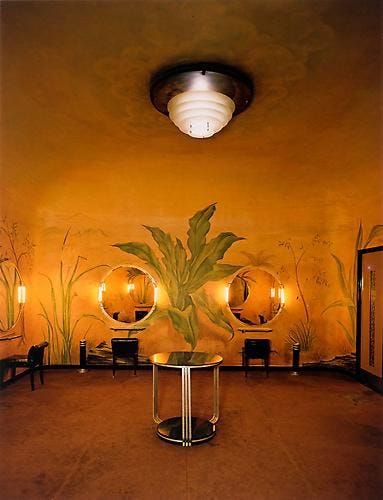
After the bombing of Pearl Harbor, significant restrictions were placed on Kuniyoshi’s personal life and business endeavors. Eventually, in a hopeful turn of events, the Whitney Museum of American Art celebrated Kuniyoshi with a retrospective of his collections in 1948 — a rare honor for a living artist.
His work at Radio City Music Hall has now been carefully restored through the use of photos and pigment analyses of the original mural [11]. You can still admire Kuniyoshi’s mural for yourself for the price of a ticket to the RCMH.
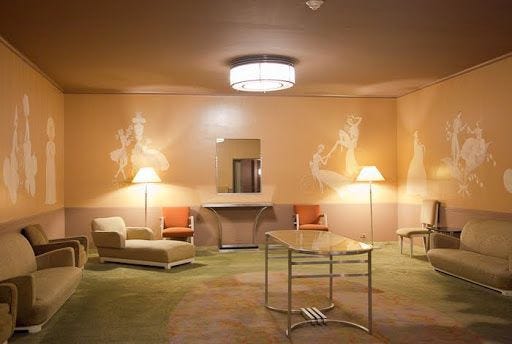
Witold Gordon (1885–1968)
Witold Gordon was a Polish native who went on to create art inspired by homes and businesses across America. Gordon became a familiar name to the American public as he created high-profile images such as the Lake Placid 1932 Winter Olympics poster, was commissioned for numerous New Yorker covers and illustrated The Travels of Marco Polo (The Venetian.)
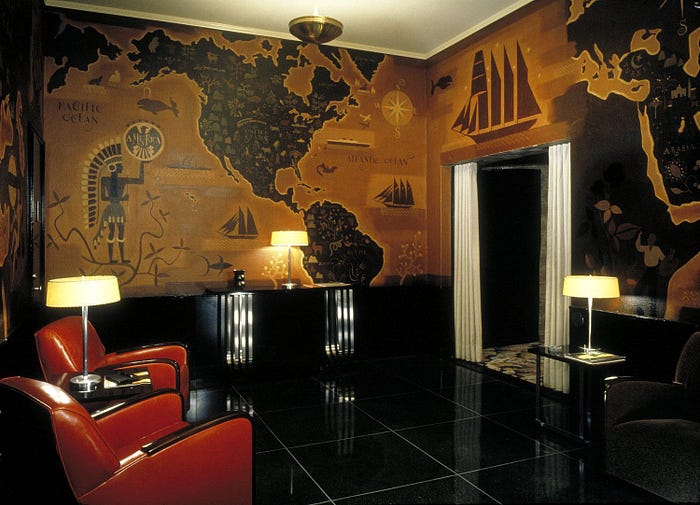
His Radio City Music Hall mural, The History of Cosmetics, is situated in one of the hall’s numerous lounges on the lower level. Sepia-tinted images of women from a multitude of cultures receive and apply offerings of makeup in the piece [12]. Strokes of pastel paint meld with the warm lighting and green brocades of the Ladies’ Lounge, making for a welcome respite from the bold tones of the Radio City mezzanine.
To create a similar mood in the Men’s Smoking Room on the first mezzanine, Gordon combined warm, comforting hues of orange and brown in his mural Maps of the World [13].

Henry Billings (1901–1987)
A simple mural of a panther in calming monochromatic hues hangs in the third floor Women’s Powder Room. The artist, Henry Billings , had a knack for painting nature and machines with a hint of surrealism. His superb grasp of lighting makes the panther mural especially intriguing to study.
Billings was born in Bronxville, New York, receiving his training and work experience in the New York City area. He became a prominent artist in the 1930s, working alongside architects to customize art for the unique needs of each building [14].
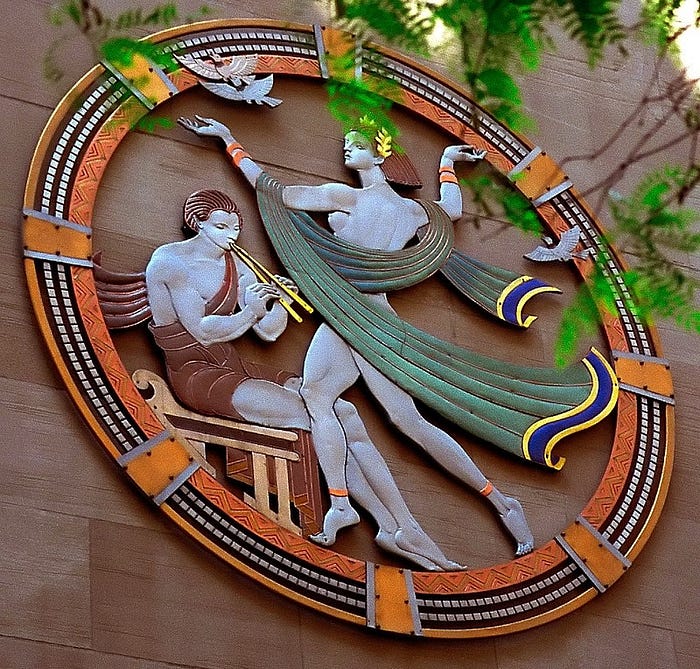
Hildreth Meière (1892–1961)
Hildreth Meière was a prolific American artist whose works decorate iconic buildings across the country such as the Nebraska State Capitol and Temple Emanu-El. Born in New York City, she gained experience as an artist sketching costume designs for the Metropolitan Opera and working for the Brooklyn Navy Yard as an architectural designer during the war [15].

Dance, Drama and Song by Meière hang in a sequence of three medallions across Radio City Music Hall’s south facade, each a full 18 feet across [16]. Though the Radio City Music Hall roundels are formed from sheet metal, Meière often designed for a wide range of mediums including mosaic tiles, marble, metal foil, oil paint and stained glass.
The urgency of pedestrians rushing along the New York City sidewalks make it tricky to view Meière’s three roundels. Try securing a good view of Dance, Drama and Song by cozying up alongside the wall near PIQ Gift Shop of Rockefeller Center directly across the street.
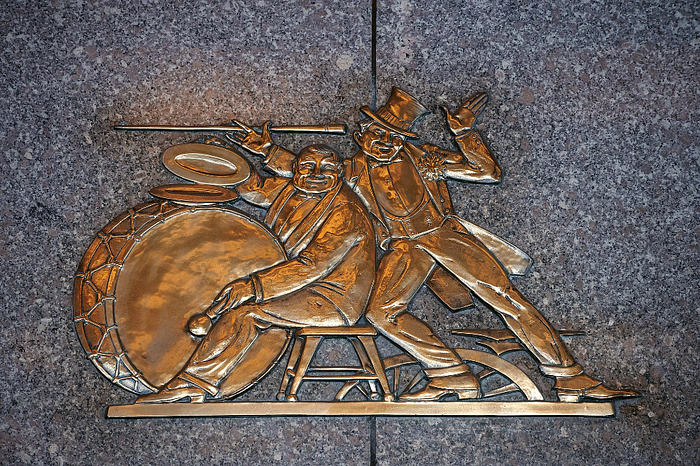
Rene Paul Chambellan (1893 — 1955)
Above Radio City Hall’s 1260 Avenue of the Americas entrance are the Acts From Vaudeville series, lined up across the granite facade above the box office doors. Rene Paul Chambellan created these six bas-relief sculptures of prancing performers and animals with delightful attention to detail.
Chambellan primarily created works of mythological inspiration in the Greco Deco and Art Deco styles, but the artist’s humor peeks through in his Acts From Vaudeville series. Emotive animals made their way into the series, including a dog wearing a clown outfit and a disapproving cat. Dancers and musicians from a range of cultural backgrounds with garish expressions are also depicted in the bronze reliefs.

Rene Paul Chambellan has his fingerprints across the city of New York: Atlas, the American Radiator Building, the Chanin Building and his much-celebrated fountainhead sculptures that adorn the promenade in the Channel Gardens.
He played an integral role in designing the architectural visuals that make Radio City Music Hall recognizable from any angle, inside and out. Throughout the entirety of Rockefeller Center, you’ll find moldings, accents, grilles and railings designed by the artist [17].
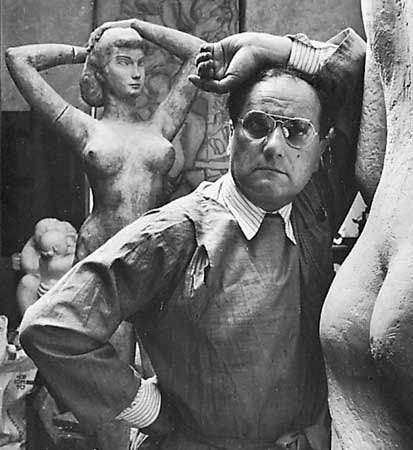
William Zorach (1889–1966)
William Zorach’s family emigrated from Lithuania to escape political unrest when he was a child, leaving behind their house, many assets and all of their land. Zorach began working odd jobs by the time he was in grade 3 to help care for the family financially. He did not continue his schooling beyond the 7th grade [18].
Zorach was able to obtain his first creative endeavor via employment with W. J. Morgan Lithograph Co., where he was encouraged to hone his artistic abilities through night classes in Cleveland [19]. Further pursuit of a career in the arts led him to the cultural enclaves of New York City and Paris.
Credited with popularizing the technique of direct carving in the United States, Zorach used this style of sculpting to create his Radio City Music Hall commission, Spirit of the Dance.
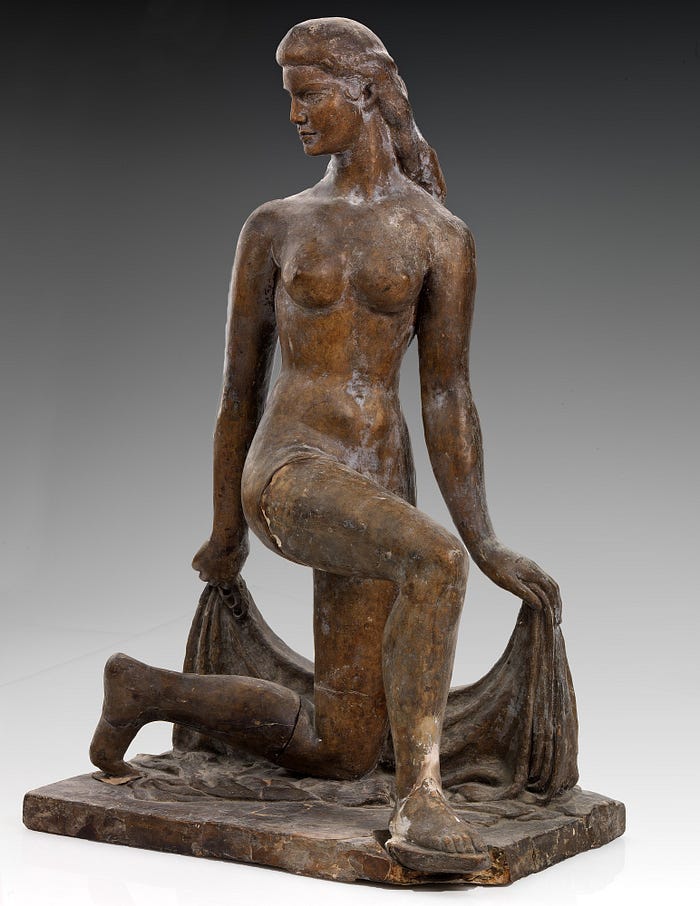
The sculpture, a female nude made of aluminum, won a hard-fought battle to live within the walls of Radio City Music Hall. Though handpicked by the Rockefeller family and purchased by the RCMH from the artist, Spirit of the Dance was quickly removed from the public eye for fear of offending theatre patrons with her larger-than-life nakedness [20].
Zorach was still able to exhibit a plaster version of Spirit of the Dance at the Downtown Gallery in Manhattan. Crowds and critics alike approved, allowing the aluminum version of Spirit of the Dance to eventually make its way back to the lower level lounge of Radio City Music Hall, where it can still be adored to this day.
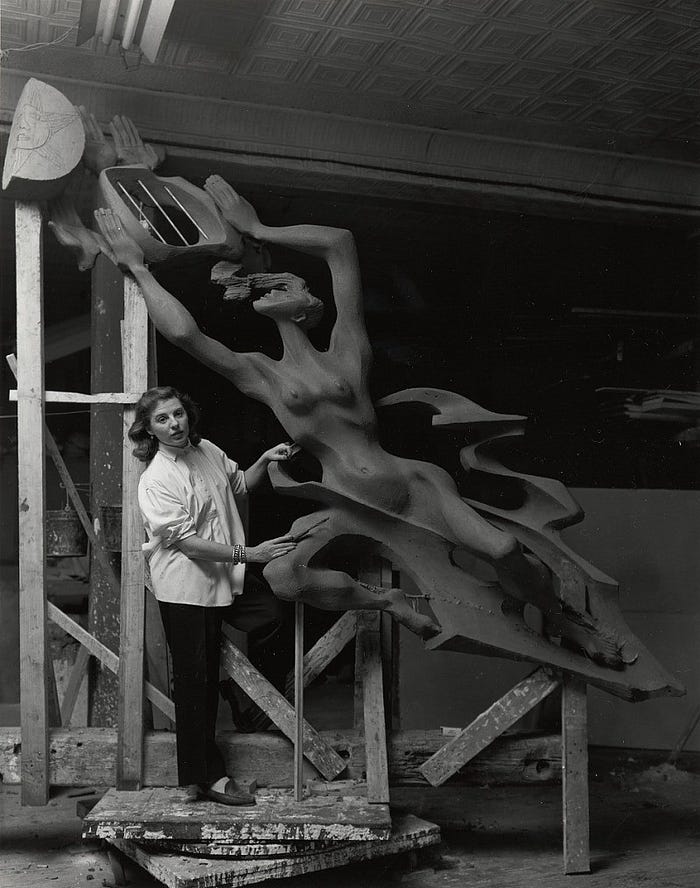
Gwen Lux (1908–1986)
A Chicago native, Gwen Lux worked primarily in steel and polyester resin concrete, completing architecture-related commissions. When she was just 20 years old, her and her husband at the time, Eugene Lux, created sculptural tiles depicting Zodiacs and Greek gods for the facade of the McGraw-Hill Building of 520 N. Michigan [21]. The work garnered much acclaim, and Lux was hired to create the Eve sculpture for Radio City Music Hall in the style of abstract realism.
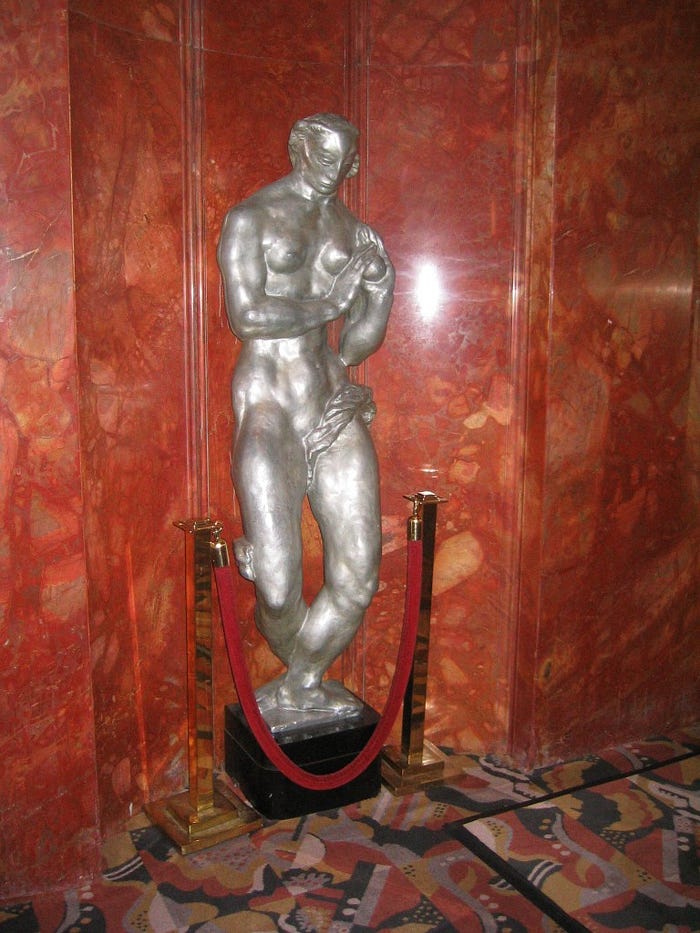
You’ll find Eve at the southwest edge of the Foyer, near the 50th Street stairs. You’ll notice that Eve by Gwen Lux appears to rise directly out of the walls, her flat posterior resting against the red marble rather than standing alone. This creates the illusion that Eve is still forming, melding with the building itself.
Following her work at Radio City Music Hall, Gwen Lux produced new artworks prolifically across America. Pooling her efforts with respected architects, she went on to produce alongside Edward Durell Stone and Eero Saarinen, including works for the iconic General Motors Technical Center in Michigan, Detroit [22].

Robert Laurent (1890 — 1970)
Robert Laurent was recognized for his skills in direct sculpture carving. He worked in a variety of natural mediums such as alabaster, mahogany and bronze. Though New York locals may know him best for Goose Girl at the Rockefeller Center’s Radio City Music Hall, The Met also holds several of Laurent’s unique pieces.
Standing far taller than any theater attendee, the aluminum nude of a young woman with a goose alongside her reflects back the lights of Radio City Music Hall in the first mezzanine. All angles of the sculpture can be admired in the sepia mirrors behind her.
At the time of the theater’s opening, the sculpture was considered as controversial as Zorach’s Spirit of the Dance and Lux’s Eve. Samuel “Roxy” Rothafel himself, the purveyor of Radio City Music Hall, spoke out against the choice of these art pieces by the Rockefeller family, saying that the sculptures’ “‘artistic merit was not within the boundary’ of his ‘critical judgement [23].’”

Concerns were raised about how the public would perceive the sculptures and how that would affect the success of the theater. As a result, Goose Girl, Eve and Spirit of the Dance were temporarily banned from Radio City.
Donald Deskey had commissioned Laurent to round out the range of subjects presented throughout Radio City Music Hall with sculptures such as Goose Girl. Though not related to the performance arts, pieces such as Goose Girl, Eve and Spirit of the Dance ensure Radio City is not just a theater, but an art gallery too [24].
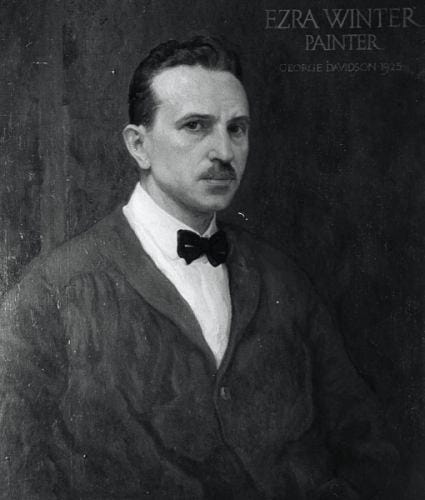
Ezra Winter (1886–1949)
Situated in the Grand Foyer of Radio City Music Hall, the fiery hues of The Fountain of Youth splash across the wall above the main staircase. Each painted character appears to float by slowly on a cloud of the memories of the past.
Ezra Winter had a way with color, often using saturated pigments next to human faces so real and expressive that onlookers feel the stories depicted must be true.

Winter worked for the U.S. Shipping Board as a camouflage artist during World War I [25], so it is not surprising that the flowing lines and intertwining shapes of Radio City’s The Fountain of Youth are reminiscent of forest camo. You won’t be able to resist snapping a photo of the mural when you see it framed by the red velvet walls and gold foil of Radio City.
While completing a project for the Bank of Manhattan (now known as 40 Wall Street), Winter damaged his coccyx during a fall from the scaffolding. The injury was such that little could be done to alleviate his pain. Winter suffered declining mental and physical health during this time [26].

The effect on Winter’s ability to work was profound. He took his own life at the age of 63 .
Winter left behind a legacy of magical art pieces, much cherished. He is responsible for the Canterbury Tales mural on the North Reading Room wall of the Library of Congress, the Michigan mural in the Art Deco lobby of the Guardian Building and, of course, The Fountain of Youth in Radio City Music Hall.

Louis Bouché (1896–1969)
Louis Bouché was a New York City native who spent his teenage years in France. There he attended professional art schools, honing his craft further during the summers [27]. Bouché’s family had long been involved in the arts — his grandfather was a painter of the French Barbizon school and his father was employed in interior design [28]. Bouché carried on the tradition.
His murals for Radio City Music Hall are typical of the subject matter he seemed to prefer: characters in their element. Collectively referred to as The Phantasmagoria of the Theater, his five murals conjure up feelings of nostalgia for the theater’s past. They are located in the Main Lounge.
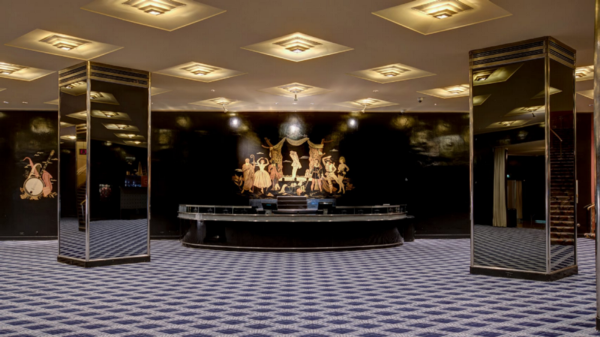
Bouché’s colorful performers and musical instruments are juxtaposed against the slick black walls of the Radio City Music Hall’s Grand Lounge. Each whimsical vignette pops out, drawing in the curious theater patron for a closer look.
Louis Bouché’s many works of art remain treasured holdings at prominent American galleries such as The Smithsonian American Art Museum, The Metropolitan Museum.

Eduard “Buk” Ulreich (1889–1966)
Eduard “Buk” Ulreich completed murals for the U.S.Courthouse in Tallahassee, magazine illustrations for the likes of Vogue, multiple sculptures and innumerable paintings throughout his career. Horses and the female form emerged as common subjects in Ulreich’s works.
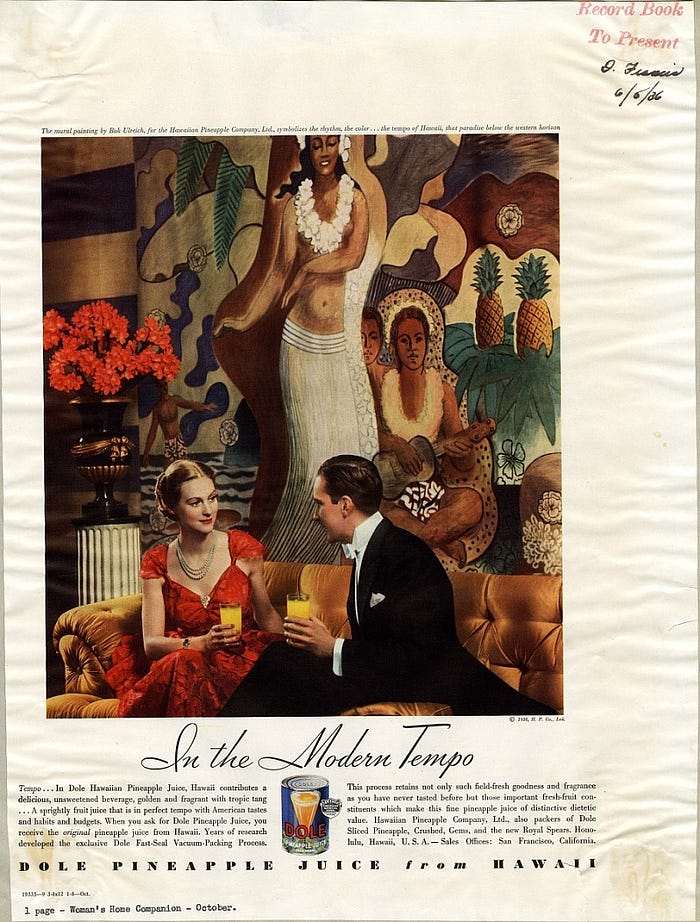
His wife, Nura Woodson Ulreich, was also an established artist and the two illustrated children’s books together from time to time [29]. Though he was born in Austria-Hungary, Ulreich spent the majority of his life in the United States where he became recognized in New York City for his western-themed work at Radio City Music Hall [30].
Up on the third mezzanine in the Men’s Lounge of Radio City music Hall is the charming leather wall canvas Wild West by “Buk” Ulreich. Wild West portrays a confident cowboy on a bucking bronco, his hat flying off towards a coiled rattlesnake.
Donald Deskey thoughtfully designed the surrounding lounge furniture, using black and white cow print paired with chrome armrests to tie in Ulreich’s cowboy with the Art Deco theater.

Stuart Davis (1892–1964)
Born in Philadelphia to an art editor and a sculptor, Stuart Davis first dabbled in art by illustrating books for his younger brother. Beginning with the realism of the Ashcan School, he eventually built his career upon Cubism and Early American Modernist principles, using line work and bold text for inspiration [31].
Distinguishable characteristics from iconic cities like New York and Paris were common subjects, sometimes depicted together in the same painting. The wild shapes and colors in much of Davis’ work seem fitting as he was an avid jazz fan.

Perhaps Davis’ best known work, Men Without Women holds a place of honor in the lower level Men’s Lounge of Radio City Music Hall. After being given as a gift to the Museum of Modern Art (1975–1998), Men Without Women came to rest once more at Radio City Music Hall [32]. The MoMa still holds a collection of Davis’ works, including a study of his Radio City Music Hall commission.
Though Davis experienced declining health in his final years, he continued to produce art until the very night before his passing, June 24, 1964 [33]. His final piece, Fin, which means “end” in the french language, was never completed.
To the Reader
Your feedback is welcomed to help ensure the accuracy of the information collected here on the artists of Radio City Music Hall. Additional photo and website resources for “The Artists of Radio City Music Hall” are available. This project is ongoing.
References
(1) Nocera, Joe. How ‘New York, New York’ Went to the Top of the Heap.” The New York Times, Dec.11, 2015. Accessed on Jan.6, 2021, https://www.nytimes.com/2015/12/12/sports/baseball/how-new-york-new-york-became-a-no-1-at-yankees-games.html
(2) Editors of MSG Entertainment Group, LLC. “Roxy Suite.” MSG.com. MSG Entertainment Group, 2020. Accessed on October 9, 2020, https://www.msg.com/venue-rentals/radio-city-music-hall-roxy-suite
(3) Editors of the Smithsonian Design Museum website. “Drawing, Carpet.” Design: ‘Singing Women,’ Radio City Music Hall Main Auditorium, New York, NY.” CooperHewett.org. Smithsonian Design Museum, n.d. Accessed on October 9, 2020, https://collection.cooperhewitt.org/objects/18487013/#image-rights
(4) Iovine, Julie V. “Piece by Piece, a Faded Icon Regains Its Art deco Glow.” The New York Times, Sept.6, 1999. Accessed on October 11, 2020, https://www.nytimes.com/1999/09/06/nyregion/piece-by-piece-a-faded-icon-regains-its-art-deco-glow.html
(5) The Editors of NYC Architecture. “Edward Durell Stone.” NYC-Architecture.com, n.d. Accessed on October 27, 2020, https://www.nyc-architecture.com/ARCH/ARCH-Stone.htm
(6) Editors of Encyclopaedia Britannica. “The Rockettes.” Britannica.com. Encyclopaedia Britannica, Inc., 2020. Accessed on October 28, 2020, https://www.britannica.com/topic/the-Rockettes#ref982700
(7) Black, Susan & Gill, Brendan. “Unchangeable.” The New Yorker, August 3, 1963 (P.19). Accessed on October 28, 2020, https://www.newyorker.com/magazine/1963/08/03/unchangeable
(8) Zeller, Jonathan. “11 Things We Learned on the Radio City Stage Door Tour.” NYCGo.com. NYC & Company, Inc. Accessed on October 28, 2020, https://www.nycgo.com/articles/11-things-we-learned-on-the-radio-city-stage-door-tour
(9) Hudes, Karen. “A Designer’s Lasting Impact.” RockefellerCenter.com. Tishman Speyer, April 4, 2019. Accessed on December 29, 2020, https://www.rockefellercenter.com/magazine/events/marguerita-mergentime-american-textiles-radio-city/
(10) Cash, Sarah. “Yasuo Kuniyoshi.” NGA Online Editions. Accessed January 07, 2021, https://purl.org/nga/collection/constituent/2600
(11) Editors of the Radio City Music Hall Facebook Page. “#StageDoorTour.” Facebook.com. Radio City Music Hall, October 27, 2017. Accessed on January 7, 2021, https://www.facebook.com/RadioCityMusicHall/photos/the-rockefeller-center-art-committee-commissioned-georgia-okeefe-to-execute-an-a/10155077953511903/
(12) Editors of Forgotten New York. “Forgotten Radio City.” Forgotten-NY.com, October 16, 2008. Accessed on October 10, 2020, https://forgotten-ny.com/2008/10/forgotten-radio-city/
(13) Arena, Chris. & L’Abbate, Anthony. “Modernist Textiles of Radio City Music Hall.” DrivingforDeco.com, April 8, 2016. Accessed on October 10, 2020, https://www.drivingfordeco.com/tag/modernist-textiles/
(14) Editors of Terra Foundation Website. “Henry Billings (Biography.)” TerraAmericanArt.org. Terra foundation for American Art, n.d. Accessed on January 1, 2021, https://collection.terraamericanart.org/view/people/asitem/items$0040null:71/0
(15) Skolnik, K. (Presenter & Producer). (2019, Oct.16). Open House 2019[Audio Podcast]. Retrieved from https://www.hildrethmeiere.org/files/assets/audio/OpenHouse2019-Skolnik.mp3
(16) Brawer, Catherine C. & Skolnik, Kathleen M. The Art Deco Murals of Hildreth Meière (New York: Andrea Monfried Editions, 2014): 150–58.
(17) The Editors of Rockefeller Center. “Acts From Vaudeville.” RockefellerCenter.com, 2020. Accessed on Jan.8, 2021, https://www.rockefellercenter.com/art/acts-from-vaudeville/
(18) Editors of Prabook.com. “William Zorach.” Prabook.com. World Biographical Encyclopedia, Inc., 2020. Accessed on Jan.8, 2021, https://prabook.com/web/william.zorach/3731775
(19) Tarbell, Roberta K. “Zorach, William (1889–1966), sculptor.” American National Biography. 1 Feb. 2000; Accessed 8 Jan. 2021. https://www.anb.org/view/10.1093/anb/9780198606697.001.0001/anb-9780198606697-e-1701369.
(20) Jewell, Edward Alden. “Plaster Cast of Zorach’s ‘Spirit of the Dance,’ Banned in Radio City, is Shown Downtown.” The New York Times, December 28, 1932. Accessed on October 14, 2020, https://timesmachine.nytimes.com/timesmachine/1932/12/28/105940012.pdf?pdf_redirect=true&ip=0
(21) Hautzinger, Daniel. “The Complicated History of One of Michigan Avenue’s Most Unusual Buildings.” Interactive.WTTW.com. WFMT, May 30, 2019. Accessed on October 16, 2020, https://interactive.wttw.com/playlist/2019/05/30/mcgraw-hill-building
(22) Rubinstein, Charlotte S. American Women Sculptors. G.K. Hall, 1990.
(23) Jewell, Edward Alden. “Plaster Cast of Zorach’s ‘Spirit of the Dance,’ Banned in Radio City, is Shown Downtown.” The New York Times, December 28, 1932. Accessed on October 14, 2020, https://timesmachine.nytimes.com/timesmachine/1932/12/28/105940012.pdf?pdf_redirect=true&ip=0
(24) Editors of the Rockefeller Center Website. “Girl and Goose (1932).” RockefellerCenter.com. Tishman Speyer, n.d. Accessed on Jan.8, 2021, https://www.rockefellercenter.com/art/girl-and-goose/
(25) Editors of the U.S. Commission of Fine Arts website. “Ezra Winter.” www.CFA.gov. U.S. Commission of Fine Arts, n.d. Accessed on October 23, 2020, https://www.cfa.gov/about-cfa/who-we-are/ezra-winter
(26) Helfand, Jessica. “Ezra Winter Project: Chapter 12.” DesignObserver.com. Observer Omnimedia LLC., 2020. Accessed on January 11, 2021, https://designobserver.com/feature/ezra-winter-project-chapter-twelve/37604
(27) Oral history interview with Louis Bouché, 1959 August 7. Archives of American Art, Smithsonian Institution. Accessed on January 11, 2021, https://www.aaa.si.edu/collections/interviews/oral-history-interview-louis-bouch-11613
(28) Editors of Art in Embassies, U.S. Department of State. “Louis Bouché.” Art.State.gov. U.S. Department of State, n.d. Accessed on January 11, 2021, https://art.state.gov/personnel/louis_bouche/
(29) Falk, Peter H. “Who Was Who in American Art.” Madison, CT.: Sound View Press, June 1, 1985.
(30) Editors of ask.ART.com. “Eduard Buk Ulreich” (Artist Biography & Facts.) askART.com. askART, 2021. Accessed on January 11, 2021, https://www.askart.com/artist/Eduard_Buk_Ulreich/4308/Eduard_Buk_Ulreich.aspx
(31) Glennon, Jen. Edited and revised, with Summary and Accomplishments added by Sandy McCain. “Stuart Davis Artist Overview and Analysis.” [Internet]. 2021. TheArtStory.org. First published on 16 Jun 2016. Updated and modified regularly. Accessed on January 12, 2021, https://www.theartstory.org/artist/davis-stuart/life-and-legacy/
(32) Admin of Masculine Interiors. “Men Without Women: Stuart Davis’ 1932 Radio City Mural.” MasculineInteriors.com. Kāv Style, 2020. Accessed on October 11, 2020, https://masculineinteriors.com/men-without-women-stuart-davis-1932-radio-city-mural/
(33) Treat, Stace. “The Spooky and Strangely Poetic Story of Fin, Stuart Davis’s Final Painting.” CrystalBridges.org. Crystal Bridges Museum of American Art, 2021. Accessed on January 12, 2021, https://crystalbridges.org/blog/the-spooky-and-strangely-poetic-story-of-fin-stuart-daviss-final-painting/
